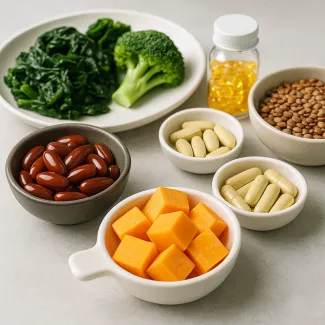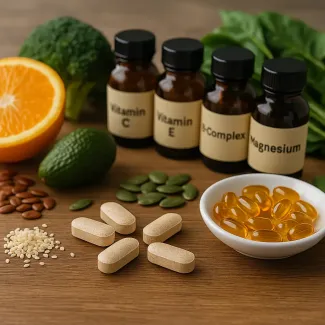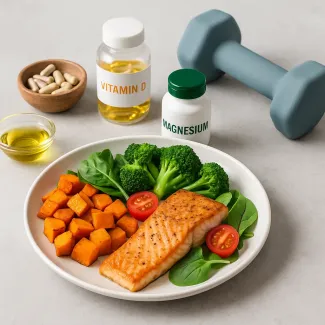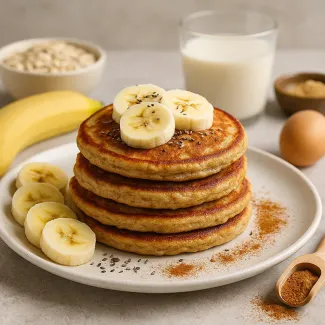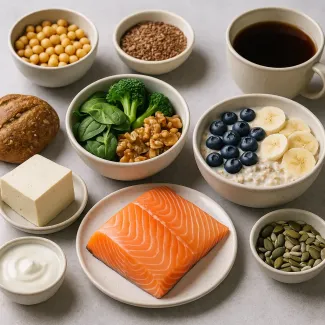
How Diet Can Support Hormonal Balance After 30
Navigating the Nutritional Challenges of PMS, Perimenopause, and Estrogen Shifts
Hormonal fluctuations are an inevitable part of a woman's life, particularly after the age of 30. These shifts—subtle at first, then progressively more pronounced—can influence not only reproductive health but also energy levels, mental clarity, skin appearance, digestion, and mood. Among the most impactful hormonal changes is the natural decline in estrogen, which begins in the early 30s and intensifies during perimenopause and menopause. At the same time, women may experience more frequent or intense PMS symptoms, making nutrition a key ally in restoring internal equilibrium.
Diet is not a cure, but a powerful modulator. The right foods can help buffer estrogen fluctuations, ease PMS discomfort, and support the body’s adaptation to menopause. Strategic changes in eating habits can significantly enhance how women feel throughout each hormonal phase, from monthly cycles to the more permanent transitions later in life.
Understanding Estrogen’s Role and Its Natural Decline
Estrogen is one of the primary sex hormones in women, responsible for regulating menstrual cycles, protecting bone density, maintaining skin elasticity, and influencing mood. As women approach their mid-thirties, estrogen production naturally begins to taper off. This process is gradual but can have a cumulative effect on multiple systems in the body.
Symptoms related to low estrogen include fatigue, brain fog, dry skin, irritability, bloating, weight gain, sleep disturbances, and decreased libido. While each woman experiences this shift differently, diet is among the few daily, controllable factors that can ease the transition.
The liver and gut microbiome are crucial for processing and eliminating excess estrogen metabolites. Therefore, nutrition plays a double role: not only in supporting hormone production but also in the safe and efficient detoxification of hormone byproducts.
Key Nutritional Principles to Support Hormonal Harmony
Emphasize Phytoestrogens for Gentle Estrogen Support
Phytoestrogens are plant compounds that can mimic estrogen’s role in the body, offering a subtle and balanced form of support. These compounds, found in specific whole foods, help fill in the hormonal gaps during times of decline.
Rich sources of phytoestrogens include:
- Flaxseeds: Especially beneficial due to their high lignan content.
- Soy (non-GMO, fermented is best): Provides isoflavones that gently bind to estrogen receptors.
- Chickpeas and lentils: Versatile legumes with mild estrogenic effects.
- Sesame seeds: Rich in lignans and healthy fats.
Integrating these foods daily can help ease symptoms of estrogen decline, especially during perimenopause and beyond.
Prioritize Fiber-Rich Foods to Regulate Estrogen Metabolism
A high-fiber diet supports the body’s ability to bind and eliminate excess estrogens through the digestive tract. Soluble and insoluble fiber both play roles in supporting gut motility, microbiome balance, and estrogen detoxification.
Excellent options include:
- Leafy greens: Kale, collards, arugula.
- Cruciferous vegetables: Broccoli, Brussels sprouts, cauliflower.
- Whole grains: Oats, quinoa, millet.
- Seeds and nuts: Chia, pumpkin, almonds.
Cruciferous vegetables also contain indole-3-carbinol (I3C), a compound that supports the safe breakdown of estrogen in the liver, reducing the risk of estrogen dominance and related symptoms such as bloating, mood swings, and weight gain.
Opt for Omega-3 Fatty Acids to Reduce Inflammation
Chronic inflammation can worsen PMS, perimenopause, and menopausal symptoms. Incorporating omega-3-rich foods into the diet can support hormone production, improve mood stability, and reduce menstrual cramps.
Best sources include:
- Fatty fish: Salmon, sardines, mackerel.
- Walnuts and flaxseed oil.
- Chia seeds and hemp seeds.
Consistent intake of omega-3s can also improve brain function, reduce the likelihood of depression during hormonal shifts, and enhance skin hydration during estrogen decline.
Balance Blood Sugar to Minimize Hormonal Chaos
Blood sugar imbalances are a hidden driver of hormonal symptoms. Spikes and crashes can trigger irritability, fatigue, sugar cravings, and mood swings, all of which are intensified by PMS or menopause.
To stabilize blood sugar:
- Combine complex carbs with healthy fats and protein.
- Avoid refined sugars and processed snacks.
- Do not skip meals—eat at regular intervals.
- Start the day with a protein-rich breakfast.
Stable glucose levels help the body manage cortisol, the stress hormone, which is deeply intertwined with estrogen and progesterone regulation.
Targeting PMS Through Nutrition
PMS is more than moodiness—it includes physical symptoms like bloating, cramping, breast tenderness, and digestive changes. These can worsen with age due to a declining hormone ratio between estrogen and progesterone.
Diet can offer notable relief. Focus on:
- Magnesium-rich foods: Spinach, dark chocolate, black beans—support muscle relaxation and reduce cramps.
- Vitamin B6 sources: Bananas, chicken, potatoes—aid neurotransmitter balance and help with mood regulation.
- Calcium: Leafy greens, dairy, almonds—shown to reduce PMS symptoms.
Avoiding alcohol, excess salt, and caffeine in the second half of the cycle can further ease discomfort, as these can exacerbate bloating and irritability.
Managing Menopause Through Dietary Strategies
As menopause sets in—typically between ages 45 and 55—estrogen production drops sharply. Women may experience night sweats, sleep disturbances, weight redistribution, and lower bone density. Targeted nutrition can help mitigate these effects and support graceful aging.
Important dietary strategies include:
- Increase calcium and vitamin D: To maintain bone strength. Add fortified plant milks, leafy greens, and moderate sun exposure.
- Boost collagen-supporting nutrients: Such as vitamin C (from berries and citrus) and zinc (from pumpkin seeds and legumes).
- Support sleep with magnesium and tryptophan-rich foods like turkey, oats, and yogurt.
Minimizing processed foods, trans fats, and sugary beverages is crucial during menopause, as these can worsen inflammation and weight gain.
The Gut–Hormone Connection
The gut microbiome influences the way estrogen is metabolized, particularly through a subset of bacteria known as the estrobolome. A healthy gut can recycle and regulate estrogen levels, while a disrupted gut flora can worsen hormonal imbalances.
To support the gut:
- Incorporate fermented foods daily: Kimchi, sauerkraut, kefir, yogurt.
- Eat prebiotic-rich plants: Onions, garlic, leeks, asparagus, bananas.
- Avoid long-term use of antibiotics unless necessary.
- Hydrate well and aim for regular bowel movements.
A strong gut–hormone connection leads to clearer skin, balanced moods, improved digestion, and better cycle regularity.
Natural Adaptogens and Herbal Support
Certain herbs and natural compounds have been traditionally used to support hormonal balance, particularly in reducing stress and supporting the adrenal glands, which become the primary producers of sex hormones post-menopause.
Popular adaptogens include:
- Ashwagandha: Balances cortisol, helps with sleep and anxiety.
- Maca root: Supports libido, energy, and mood.
- Rhodiola rosea: Enhances endurance, reduces fatigue.
- Chasteberry (Vitex agnus-castus): Especially helpful for PMS and cycle irregularity.
While not a replacement for nutrition, adaptogens can complement a food-first strategy, especially in stressful phases of hormonal transition.
Hydration and Hormone Function
Hormones rely on cell-to-cell communication, and water is the medium through which this occurs. Even mild dehydration can affect energy, mental clarity, and cycle regularity.
Ensure at least 2 liters of clean water daily, more if active or during summer months. Herbal teas, broths, and high-water foods like cucumbers and berries also contribute to daily hydration.
Avoid excessive caffeine and alcohol, which act as diuretics and can deplete key minerals necessary for hormone production.
Protein Intake and Muscle Preservation After 30
After the age of 30, women begin to lose muscle mass gradually—a condition called sarcopenia. Protein becomes increasingly important, not just for body composition but also for hormone synthesis.
Focus on:
- Complete proteins: Eggs, fish, lean meats, tofu, quinoa.
- Plant proteins: Lentils, beans, tempeh, spirulina.
- Distribute protein throughout the day, not just at dinner.
- Aim for 1.2–1.5 g of protein per kg of body weight, depending on activity levels.
Protein-rich diets support satiety, metabolic rate, and tissue repair, all of which are essential during times of hormonal change.
Caffeine, Alcohol, and Their Impact on Hormones
Both caffeine and alcohol influence hormone pathways. Caffeine increases cortisol, which can disrupt estrogen and progesterone balance, particularly in women with adrenal fatigue or chronic stress. Alcohol impairs liver detoxification, where excess estrogens are processed and eliminated.
Tips for moderation:
- Limit caffeine to 1–2 cups of coffee per day, preferably before noon.
- Replace some coffee with herbal infusions or matcha.
- Restrict alcohol to 1–2 servings per week, choosing organic red wine or low-sugar cocktails when possible.
Avoiding these triggers can ease hot flashes, irritability, bloating, and sleep disturbances commonly linked to hormonal shifts.
Meal Timing and Circadian Alignment
Eating in tune with your natural circadian rhythm can support hormonal secretion, digestion, and metabolism. This concept is especially important for women who suffer from insomnia, night sweats, or energy crashes.
Effective strategies:
- Eat the largest meal at midday when digestive fire is strongest.
- Avoid eating heavy meals late at night.
- Maintain a 12–14 hour overnight fast, such as finishing dinner by 7 pm and eating breakfast at 8–9 am.
This gentle approach to intermittent fasting helps regulate insulin, support liver detoxification, and improve hormonal regularity without causing stress to the female body.
Micronutrients That Matter
Hormonal health depends on a spectrum of vitamins and minerals, many of which are depleted by stress, poor diet, or hormonal medications.
Top micronutrients to prioritize:
- Vitamin B-complex: For mood, energy, and hormone synthesis.
- Magnesium: For cramps, sleep, stress, and blood sugar balance.
- Zinc: For fertility, skin, and immune function.
- Selenium: For thyroid support and antioxidant activity.
- Iron: Especially for menstruating women, to prevent fatigue.
- Iodine: For thyroid regulation.
Whole foods should be the first source, but targeted supplementation may be beneficial during perimenopausal or postmenopausal years. Blood tests can help assess deficiencies and guide choices.
Emotional Well-being and Food-Mood Connection
Hormonal changes often coincide with mood swings, anxiety, and low motivation. What we eat can directly affect our neurotransmitters, particularly serotonin, which influences happiness, sleep, and appetite.
Nutritional practices that support mental balance:
- Include tryptophan-rich foods like turkey, pumpkin seeds, oats, and bananas.
- Eat regularly to avoid energy dips and mood crashes.
- Limit inflammatory foods like sugar, trans fats, and artificial additives.
Mood-supportive nutrients include omega-3s, magnesium, and vitamin D—deficiencies in these are common during hormonal transitions.
Movement, Recovery, and Nutrition
Physical activity enhances the benefits of nutrition. It stimulates hormonal release, regulates insulin, and supports mood and sleep. However, overtraining can be counterproductive, particularly in hormonally sensitive phases.
Best practices:
- Focus on strength training, yoga, and moderate cardio.
- Avoid prolonged high-intensity sessions that deplete cortisol reserves.
- Prioritize recovery with protein intake, hydration, and restorative sleep.
Recovery is essential. Women over 30 should treat sleep and nourishment as partners in healing and hormonal balance.

